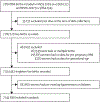Association between maternal pre-pregnancy obesity and preterm birth according to maternal age and race or ethnicity: a population-based study
- PMID: 31395506
- PMCID: PMC6759835
- DOI: 10.1016/S2213-8587(19)30193-7
Association between maternal pre-pregnancy obesity and preterm birth according to maternal age and race or ethnicity: a population-based study
Abstract
Background: The relation between maternal pre-pregnancy obesity and preterm birth is controversial and inconclusive. We aimed to clarify the association between pre-pregnancy obesity and preterm birth by maternal age and race or ethnicity in a large, multiracial, multiethnic, and diverse population in the USA.
Methods: We did a population-based cohort study using nationwide birth certificate data from the US National Vital Statistics System for 2016 and 2017. We included all mothers who had a live singleton birth and who did not have pre-existing hypertension or diabetes. Pre-pregnancy obesity was defined as a pre-pregnancy BMI of at least 30 kg/m2. Preterm birth was defined as gestational age of less than 37 weeks. We used logistic regression models adjusted for maternal age, race or ethnicity, parity, education levels, smoking during pregnancy, previous history of preterm birth, marital status, infant sex, and timing of initiation of prenatal care to estimate the odds ratio (OR) of preterm birth.
Findings: We included 7 141 630 singleton livebirths in our analysis, 527 637 (7·4%) of which were preterm births. 127 611 (7·5%) Hispanic mothers, 244 578 (6·6%) non-Hispanic white mothers, and 102 509 (10·4%) non-Hispanic black mothers had preterm births. In the overall population, maternal pre-pregnancy obesity was significantly associated with an increased risk of preterm birth compared with maternal pre-pregnancy healthy weight (ie, BMI of 18·5-24·9 kg/m2; adjusted OR 1·18 [95% CI 1·18-1·19]). In non-Hispanic white women, maternal obesity was inversely associated with preterm birth among those younger than 20 years (adjusted OR 0·92 [95% CI 0·88-0·97]), but positively associated with preterm birth among those aged 20 years or older (1·04 [1·01-1·06], 1·20 [1·18-1·23], 1·34 [1·31-1·37], 1·40 [1·36-1·43], and 1·39 [1·31-1·46] among those aged 20-24 years, 25-29 years, 30-34 years, 35-39 years, and ≥40 years, respectively). In Hispanic women, maternal obesity was not associated with preterm birth among those younger than 20 years (0·98 [0·93-1·04]), but positively associated with preterm birth among those aged 20 years or older (1·06 [1·03-1·09], 1·21 [1·17-1·24], 1·32 [1·28-1·36], 1·38 [1·33-1·43], and 1·30 [1·22-1·40] among those aged 20-24 years, 25-29 years, 30-34 years, 35-39 years, and ≥40 years, respectively). In non-Hispanic black women, maternal obesity was inversely associated with preterm birth among those younger than 30 years (0·76 [0·71-0·81] in those <20 years, 0·83 [0·80-0·86] in those aged 20-24 years, and 0·98 [0·95-1·01] among those aged 25-29 years), but positively associated with preterm birth among those aged 30 years or older (1·15 [1·11-1·19], 1·26 [1·20-1·32], and 1·29 [1·18-1·42] among those aged 30-34 years, 35-39 years, and ≥40 years, respectively).
Interpretation: Maternal pre-pregnancy obesity is significantly associated with the risk of preterm birth in the general population, but the risk differs according to maternal age and race or ethnicity. Future investigation is warranted to understand the underlying mechanisms.
Funding: US National Institutes of Health.
Copyright © 2019 Elsevier Ltd. All rights reserved.
Conflict of interest statement
Declaration of interests
We declare no competing interests.
Figures




Comment in
-
Pre-pregnancy weight and preterm birth: a causal relation?Lancet Diabetes Endocrinol. 2019 Sep;7(9):663-665. doi: 10.1016/S2213-8587(19)30252-9. Epub 2019 Aug 5. Lancet Diabetes Endocrinol. 2019. PMID: 31395507 No abstract available.
-
Maternal pre-pregnancy obesity and preterm birth: more explorations needed.Lancet Diabetes Endocrinol. 2019 Nov;7(11):829. doi: 10.1016/S2213-8587(19)30320-1. Lancet Diabetes Endocrinol. 2019. PMID: 31621590 No abstract available.
-
Maternal pre-pregnancy obesity and preterm birth: more explorations needed - Authors' reply.Lancet Diabetes Endocrinol. 2019 Nov;7(11):829-830. doi: 10.1016/S2213-8587(19)30321-3. Lancet Diabetes Endocrinol. 2019. PMID: 31621591 No abstract available.
-
The causal influence of maternal obesity on preterm birth.Lancet Diabetes Endocrinol. 2020 Feb;8(2):101-103. doi: 10.1016/S2213-8587(19)30406-1. Epub 2019 Dec 20. Lancet Diabetes Endocrinol. 2020. PMID: 31882345 No abstract available.
References
-
- Martin JA, Hamilton BE, Osterman MJK, Driscoll AK, Drake P. Births: final data for 2017. Natl Vital Stat Rep 2018; 67: 1–50. - PubMed
-
- Liu P, Xu L, Wang Y, et al. Association between perinatal outcomes and maternal pre-pregnancy body mass index. Obes Rev 2016; 17: 1091–102. - PubMed
-
- Poston L, Caleyachetty R, Cnattingius S, et al. Preconceptional and maternal obesity: epidemiology and health consequences. Lancet Diabetes Endocrinol 2016; 4: 1025–36. - PubMed
Publication types
MeSH terms
Grants and funding
LinkOut - more resources
Full Text Sources
Medical

